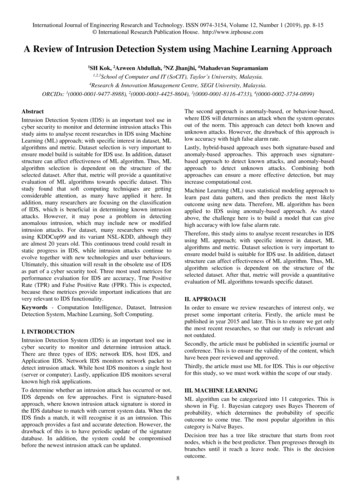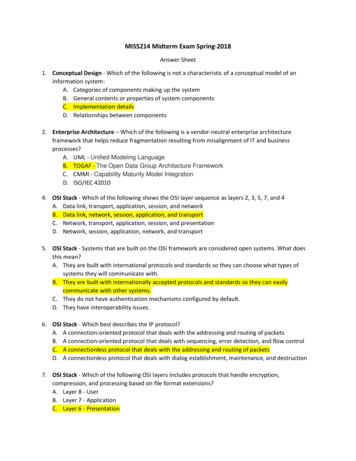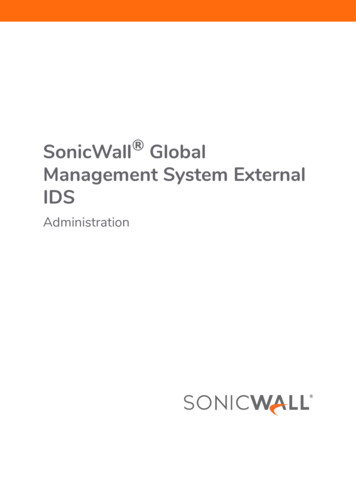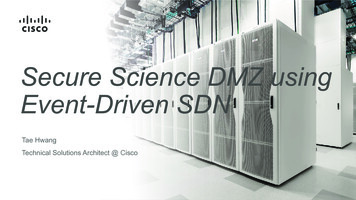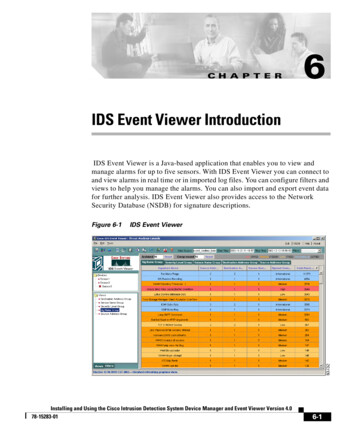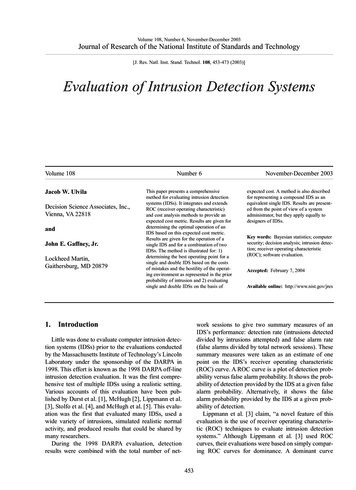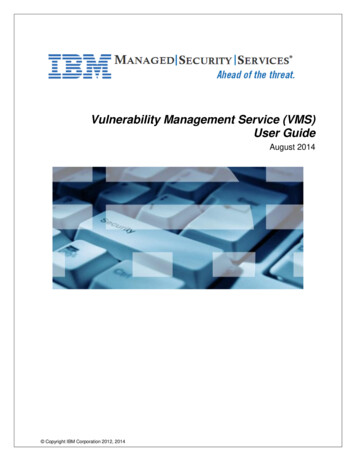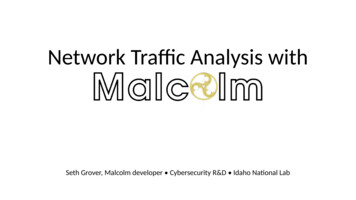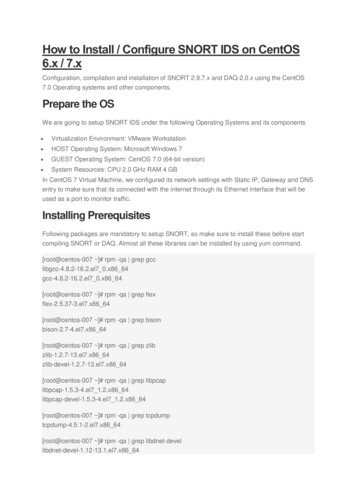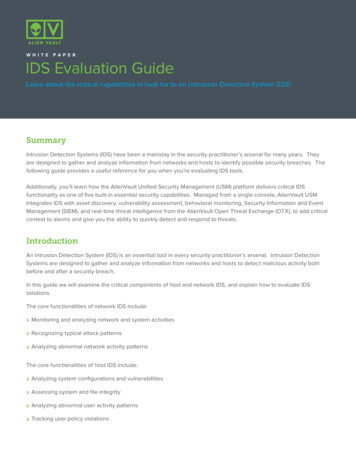
Transcription
W H I T EPA P E RIDS Evaluation GuideLearn about the critical capabilities to look for in an Intrusion Detection System (IDS)SummaryIntrusion Detection Systems (IDS) have been a mainstay in the security practitioner’s arsenal for many years. Theyare designed to gather and analyze information from networks and hosts to identify possible security breaches. Thefollowing guide provides a useful reference for you when you’re evaluating IDS tools.Additionally, you’ll learn how the AlienVault Unified Security Management (USM) platform delivers critical IDSfunctionality as one of five built-in essential security capabilities. Managed from a single console, AlienVault USMintegrates IDS with asset discovery, vulnerability assessment, behavioral monitoring, Security Information and EventManagement (SIEM), and real-time threat intelligence from the AlienVault Open Threat Exchange (OTX), to add criticalcontext to alarms and give you the ability to quickly detect and respond to threats.IntroductionAn Intrusion Detection System (IDS) is an essential tool in every security practitioner’s arsenal. Intrusion DetectionSystems are designed to gather and analyze information from networks and hosts to detect malicious activity bothbefore and after a security breach.In this guide we will examine the critical components of host and network IDS, and explain how to evaluate IDSsolutions.The core functionalities of network IDS include:››Monitoring and analyzing network and system activities››Recognizing typical attack patterns››Analyzing abnormal network activity patternsThe core functionalities of host IDS include:››Analyzing system configurations and vulnerabilities››Assessing system and file integrity››Analyzing abnormal user activity patterns››Tracking user policy violations
W H I T EPA P E RTraditional IDS has been around for many years and forms the backbone of any good security practice. But in recentyears, it has become apparent that traditional capabilities of IDS are not sufficient to deliver a complete securitysolution. IDS as a standalone tool provides too narrow a view of the threat vectors facing your organization. Intrusiondetection needs to be augmented with other security capabilities to achieve effective threat detection and response.Security teams are typically overstressed and under-resourced trying to stay ahead of the evolving threat landscape,and often do not have the time to wade through mountains of alerts. Organizations need an IDS solution thatcan prioritize alerts and provide a level of context to each alert. Receiving an alert in the context of your entireinfrastructure allows you to focus your time on addressing the real threats. In addition, threat intelligence is anothercrucial component to augment the effectiveness of your IDS solution. Threat intelligence is information aboutmalicious actors, their tools, infrastructure and methods. Effective threat intelligence is essential for making sense ofmountains of internal and external threat data to enable efficient threat detection and prioritized response. If you canfind a solution that includes these key capabilities, you are well on your way to an effective security program.The following are the key questions you need to ask when evaluating an IDS solution:››Does it have both Network Intrusion Detection Systems (NIDS) and Host Intrusion Detection Systems (HIDS)?››Does the IDS use a signature-based approach?››What is the throughput of the IDS?››Does the IDS perform protocol analysis?››Does the IDS do aggregation (i.e. combining alerts)?››Does the IDS have integration capabilities (e.g. with other platforms)?››Does the IDS have contextual enhancement? Does it feed into SIEM?››How quickly is the IDS able to detect the latest threats via new updates?Network IDS or Host IDSThe first thing you need to determine is if you need a Host-based Intrusion Detection System (HIDS) or a NetworkBased Intrusion Detection (NIDS) system. Intrusion detection traditionally includes both of these components, andboth are essential for a complete security solution.NIDSNetwork-based IDS performs an analysis of all traffic passing through the network and matches the traffic to thelibrary of known attacks. An alert is sent to the administrator when a match to a known attack occurs or if abnormalbehavior is identified.The advantage of network-based IDS solutions is that they can monitor an entire network with only a few well-situatednodes or devices, and they impose little overhead on a network. One disadvantage of Network-based IDS solutionsis that the devices have trouble monitoring high-volume traffic. When the traffic volume exceeds the IDS’ capabilities,the solution will start dropping packets,1 causing it to miss attacks launched during peak traffic periods.1Refer also to the discussion of throughput in the ‘Throughput’ section below. 2016 AlienVault. All rights reserved. AlienVault and the AlienVault logo are trademarks or reg istered trademarks of AlienVault.All other names and trademarks are for identification purposes and are the property of their respective owners.2
W H I T EPA P E RHIDSA Host-based IDS monitors individual hosts on your network for malicious activity.The Host IDS takes a snap shot of your existing system key files and applications and matches it to the previous snapshot. If the critical system files were modified or deleted, an alert is sent to the administrator to investigate. Thisfunctionality is also known as file integrity monitoring.The advantage of HIDS is that these systems in general tend to be more accurate than Network-based IDS becausethey analyze the server’s log files, not just network traffic patterns. Host-based IDS can analyze activities on the hostin a very detailed manner. It can often determine which processes and/or users are involved in malicious activities,and can tell you when an attack has potentially succeeded. The issue with host-based systems is that they tend tobe expensive and resource-intensive because they require installing an agent on each host you wish to monitor, withlicensing generally charged on a per-seat basis.Solution recommendations:For a truly effective security control strategy, you need both NIDS and HIDS for your intrusion detection solution.NIDS and HIDS complement each other, and each provide functionality that enhances the effectiveness of the otherby providing visibility into all traffic on the network as well as traffic targeting each monitored host.AlienVault USM capabilities:AlienVault Unified Security Management (USM) provides both Network IDS and Host IDS functionality. With AlienVaultUSM, the Host IDS is simple to set up and comes integrated out-of-the box with Network IDS and a score of additionalbuilt-in security tools, all managed from a single console, to enable you to quickly correlate events, detect threats, andprioritize response. 2016 AlienVault. All rights reserved. AlienVault and the AlienVault logo are trademarks or reg istered trademarks of AlienVault.All other names and trademarks are for identification purposes and are the property of their respective owners.3
W H I T EPA P E RSignature-based vs Anomaly-based IDS SystemsOverview:You need to determine if you want an IDS solution that is signature-based or anomaly-based. There are advantagesand disadvantages of both.Signature-based detectionSignature detection, also known as pattern matching, involves searching network traffic for packet sequences (such asfile hashes) that are known to be malicious. Once a match to a signature is found, the system generates an alert.A key advantage of signature-based IDS is that signatures are easy to develop and understand. In addition, patternmatching can be performed very quickly.But there are certain limitations of this method. Because the signature can only detect known attacks, someapproaches to signature-based detection require the creation of a signature for every attack, and thus previouslyunseen attacks cannot be detected. In addition, signature engines are prone to false positives because some normalnetwork activity can be misinterpreted as malicious. However, there are ways to mitigate these disadvantages, suchas using a strong correlation engine. Correlation engines detect relationships between different types of events toidentify malicious activity. In doing so, correlation engines turn disparate data into actionable information.Anomaly-based detectionAnomaly-based detection incorporates the concept of a baseline for normal network behavior. Events in an anomalydetection engine are identified by any behaviors that fall outside of the predefined or accepted model of behavior.One advantage of anomaly-based detection is that a new attack for which a signature does not exist can be detectedif the behavior falls out of the normal traffic patterns. A disadvantage of anomaly-based detection engines is thedifficulty of defining rules, as the rules need to be tested extensively for accuracy, and without entering good baselineknowledge of your network, they can generate many false positives. In addition, anomaly detection engines havedifficulty translating easily across differing security vendor platforms.Solution recommendations:Signature-based IDS solutions are the most practical given the resource limitations of most organizations, and oneof the most effective solutions for short-term threat detection. For signature-based solutions, you need to look for asolution that rapidly updates signatures when new vulnerabilities and exploits are discovered. The signatures shouldbe updated frequently to ensure they can detect the latest threats as well as reduce false positive alerts. The solutionalso needs to have the ability to import signatures from commercial and open-source signature feed providers.AlienVault USM capabilities:AlienVault USM delivers IDS using the signature-based detection method, and the signatures are updated severaltimes a week by the AlienVault Labs threat research team (see a history of updates in the AlienVault forums). TheUSM platform overcomes the traditional shortcomings of the signature-based method with its strong correlationengine. Leveraging the numerous security controls built into the USM platform, the AlienVault correlation engine usesbuilt-in correlation rules to detect relationships between different types of events occurring in one or more monitoredassets to identify threats. The use of multiple data sources greatly enhances USM’s capability to identify maliciousactivity. In addition, AlienVault USM integrates Threat Intelligence powered by the Open Threat Exchange (OTX) intothe platform, which provides additional context to the IDS engine and delivers signatures on the latest exploits. 2016 AlienVault. All rights reserved. AlienVault and the AlienVault logo are trademarks or reg istered trademarks of AlienVault.All other names and trademarks are for identification purposes and are the property of their respective owners.4
W H I T EPA P E RThroughputOverview:The next thing to understand about your IDS solution is throughput. Throughput is the maximum amount of trafficthat can be successfully processed in one second by the Network IDS system. Your NIDS must be able to keep upwith your network traffic. This will largely depend upon your network requirements. Every organization has differentbandwidth needs. Typically, the range of 100 Mbps to 1 Gbps is sufficient for most networks. (It is important toremember that networks are full duplex, meaning a 100 Mbps link can generate 200 Mbps of traffic.)Note that one concern of IDS deployments is the performance factor. Many NIDS implementations have a tendency todrop packets due to the high throughput of today’s high bandwidth network devices. Therefore, you must determinewhere you will put the Network IDS, and how much bandwidth you’ll need.Solution recommendations:Determine your network requirements (i.e. understand what applications you are running, how much bandwidth eachapplication is using, how many users your network is supporting, etc.) and select a NIDS solution that can keep up withyour network traffic.AlienVault USM capabilities:AlienVault USM provides enough throughput for most typical organizations. The NIDS throughput of the AlienVault 2016 AlienVault. All rights reserved. AlienVault and the AlienVault logo are trademarks or reg istered trademarks of AlienVault.All other names and trademarks are for identification purposes and are the property of their respective owners.5
W H I T EPA P E RUSM All-in-Ones (AIO) appliances is 100 Mbps, while the throughput of the AlienVault USM Sensors ranges from 100Mbps for Remote Sensors to 5 Gbps for Enterprise Sensors.Protocol analysisOverview:The next thing to evaluate in your IDS solution is the level of protocol analysis that it performs. In protocol analysis, theNetwork IDS examines Transmission Control Protocol (TCP) and User Diagram Protocol (UDP) payloads, which containother protocols such as DNS, FTP, HTTP and SMTP (i.e. the Layer 7 applications). (As an example, threats can betransmitted through legitimate DNS traffic, which isn’t normally inspected or blocked.) The IDS understands how theseprotocols are supposed to work, and can fully decode and interpret the protocols to detect threats using signatures.This process allows a much larger range of signatures to be created than would be possible through more basicsignature techniques.Solution recommendations:Make sure your IDS solution does robust protocol analysis, including application layer decoding of HTTP, FTP, SMTP,SSL, SSH and DNS protocols.AlienVault USM capabilities:AlienVault USM performs protocol analysis to deliver an extensive range of signatures. 2016 AlienVault. All rights reserved. AlienVault and the AlienVault logo are trademarks or reg istered trademarks of AlienVault.All other names and trademarks are for identification purposes and are the property of their respective owners.6
W H I T EPA P E RAggregationOverview:IDS systems generate an enormous amount of data, including scores of alerts and events based upon the signaturesin the system. Often there are duplicative events from various systems, and other alerts that could be characterizedas noise. This is a major pain point for all organizations – you get flooded with alerts. This can also lead to inadvisableworkarounds, including restricting or turning off the signatures altogether. These workarounds are not advisable formultiple reasons. First, an attack may in fact be happening, and you need to be able to properly identify it. In addition,you will lose capabilities that are needed for reporting purposes.The optimal way to deal with this pain point is to use an IDS solution that has aggregation capabilities. Aggregation,the ability to combine events into one alert, is critical to help you focus your efforts on detecting actual threats. Youneed to be able to correlate the output of several systems and give your security operators a condensed view of thereported security issues.Solution recommendations:Select an IDS solution that has aggregation capabilities.AlienVault USM capabilities:AlienVault USM delivers cutting edge aggregation functionality. It accomplishes this with its strong correlation engine,which links together disparate events from IDS and other built-in security controls to consolidate event data and turnthe data into useful information. In addition, the correlation directives that are delivered by AlienVault Labs ensure thatevery alert generated is meaningful and actionable. 2016 AlienVault. All rights reserved. AlienVault and the AlienVault logo are trademarks or reg istered trademarks of AlienVault.All other names and trademarks are for identification purposes and are the property of their respective owners.7
W H I T EPA P E RIntegrationOverview:As critical as IDS is to your security program, one security tool is not sufficient. Most companies have multiple securitytools to achieve effective threat detection and response. To get the most out of your IDS, it needs to be integratedwith other security tools. This means that it needs to have the capability to send and receive alert data to and fromother data sources so that you achieve better context and correlation of threat data and better prioritization of alerts.Solution recommendations:Choose an IDS solution that has strong integration capabilities.AlienVault USM capabilities:AlienVault USM was built to integrate data with other platforms, and deliver exceptional correlation capabilities. It isan intuitive, comprehensive security platform that integrates seamlessly with external security tools, in addition to thebuilt-in integration of IDS with asset discovery, vulnerability assessment, behavioral monitoring, and SIEM capabilities.With AlienVault USM, you’ll have the ability to incorporate data from 3rd party technologies and devices to bettercorrelate network activity and identify malicious activity. This data feeds into AlienVault USM’s correlation engine togreatly enhance threat detection and response capabilities.Contextual EnhancementOverview:An IDS on its own can only do so much; IDS data needs to be supplemented with additional data about the network,applications, devices, and users to be really meaningful. The way to do this is with context. Putting threats in context 2016 AlienVault. All rights reserved. AlienVault and the AlienVault logo are trademarks or reg istered trademarks of AlienVault.All other names and trademarks are for identification purposes and are the property of their respective owners.8
W H I T EPA P E Ris essential for a truly effective IDS solution. This requires correlating information from a range of sources, includinginformation from internal sources such as NIDS, HIDS, system logs, firewall logs, etc., as well as from external sources.This correlation capability is a must-have for a successful security program.An effective IDS system also needs to feed into a Security Information and Event Management (SIEM) solution. SIEMsoftware is designed to import information from various security-related logs, including those from IDS, vulnerabilityassessment, and asset management tools, and to correlate events among them. Integration with SIEM providesadditional needed context for your alerts.Solution recommendations:You need to select an IDS solution with the ability to deliver supplemental data about your hosts to provide additionalcontext to the alerts. This will improve the efficiency and effectiveness of your threat detection capabilities.AlienVault USM capabilities:AlienVault USM delivers essential security capabilities on top of its IDS in a single platform. The IDS functionalityis integrated with asset discovery, vulnerability assessment, and behavioral monitoring in a native SIEM solution toprovide critical context. And the Threat Intelligence powered by OTX and delivered by AlienVault Labs providesadditional context to your alerts, in addition to the coordinated set of rules delivered to the USM platform by the Labs 2016 AlienVault. All rights reserved. AlienVault and the AlienVault logo are trademarks or reg istered trademarks of AlienVault.All other names and trademarks are for identification purposes and are the property of their respective owners.9
W H I T EPA P E Rteam. The constant updates from AlienVault Labs enable the AlienVault USM platform to analyze the mountain ofevent data from all of your data sources. Over 2,500 correlation directives link events to identify threats targetingyour network, eliminating the need for you to spend hours creating your own. The USM platform delivers aprioritized assessment of the threats targeting your network, telling you the most important threats to focus on rightnow, and provides guidance on how to respond to those threats.AlienVault USMTMSIEMASSET DISCOVERY Log Management OTX threat data SIEM Event Correlation Incident Response Active & Passive Network Scanning Asset Inventory Software InventoryBEHAVIORALMONITORING NetFlow Analysis Service AvailabilityMonitoringAlienVault LabsThreat IntelligenceVULNERABILITY ASSESSMENTINTRUSION DETECTION Network IDS Host IDS File Integrity Monitoring (FIM) Continuous Vulnerability Monitoring Authenticated / UnauthenticatedActive Scanning Remediation VerificationSummaryIntrusion Detection Systems are one of the most effective security controls available today, particularly when IDSdata can be correlated with asset information, vulnerability data, and threat intelligence to provide valuable contextand prioritization of alarms. Using the information in the guide above, you’ll be able to effectively assess thecapabilities of the many IDS tools available and find the solution that best fits your needs.AlienVault Unified Security Management OverviewAlienVault’s Unified Security Management (USM) platform provides a fast and cost-effective way for organizationswith limited security staff and budget to address compliance and threat management needs. With all of the essentialsecurity controls built-in, AlienVault USM puts complete security visibility within fast and easy reach of smallersecurity teams who need to do more with less. 2016 AlienVault. All rights reserved. AlienVault and the AlienVault logo are trademarks or reg istered trademarks of AlienVault.All other names and trademarks are for identification purposes and are the property of their respective owners.10
W H I T EPA P E RThe AlienVault USM platform provides five essential security capabilities that provide the technology you need.USM integrates threat intelligence from AlienVault Labs and the Open Threat Exchange (OTX), which eliminates theneed for IT teams to spend precious time conducting their own research on emerging threats. The AlienVault Labsthreat research team spends countless hours mapping out the different types of attacks, the latest threats, suspiciousbehavior, vulnerabilities and exploits they uncover across the entire threat landscape. It produces actionable threatintelligence, which is information about malicious actors, their tools, infrastructure and methods, built into the USMplatform.AlienVault OTX, the world’s first truly open threat intelligence community that enables collaborative defense withactionable, community-powered threat data, provides global insight into attack trends and bad actors. USM correlatesthreat data from OTX to alert you when it detects Indicators of Compromise (IOCs) identified in OTX interacting withassets in your environment. Such interactions might consist of malicious IPs communicating with systems, malwaredetected in your network, or outbound communication with command-and-control (C&C) servers.About AlienVaultAlienVault has simplified the way organizations detect and respond totoday’s ever evolving threat landscape. Our unique and award-winningapproach, trusted by thousands of customers, combines the essential securitycontrols of our all-in-one platform, AlienVault Unified Security Management,with the power of AlienVault’s Open Threat Exchange, the world’s largestcrowdsourced threat intelligence community, making effective and affordablethreat detection attainable for resource-constrained IT teams. AlienVault is aprivately held company headquartered in Silicon Valley and backed by TridentCapital, Kleiner Perkins Caufield & Byers, Institutional Venture Partners, GGVCapital, Intel Capital, Jackson Square Ventures, Adara Venture Partners,Top Tier Capital and Correlation Ventures. For more information visit www.AlienVault.com or follow us on Twitter (@AlienVault).
AlienVault USM delivers IDS using the signature-based detection method, and the signatures are updated several times a week by the AlienVault Labs threat research team (see a history of updates in the AlienVault forums). The USM platform overcomes the traditional shortcomings of the signature-based method with its strong correlation engine.
